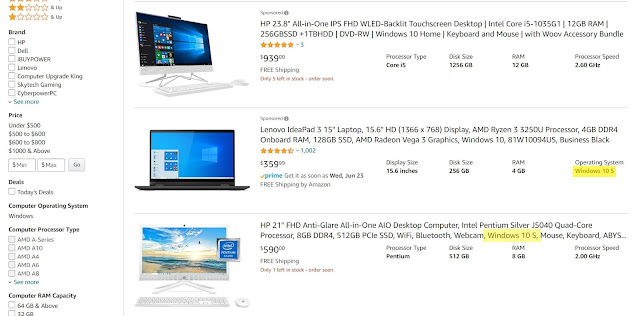Over the last month or so I've noticed that all of the ads and retail descriptions of low-end PCs I have been seeing have updated their description of the included version of Windows. Instead of promising that purchasing a new PC includes "Windows 10", "Windows 10 Home" or "Windows 10 Pro", the operating system was listed as "Windows 10 S", as shown in the screenshot below:
Windows 10 "S-Mode" isn't new: it was released as part of the Windows update released in April 2018. But using the term in a sales context - promising new PCs will include Windows S-Mode, while not clarifying what actual version of Windows will be included, is very new and suggests there is a tectonic shift in thinking about the Windows operating system and its relationship to consumers.
What is "S-Mode"?
According to Microsoft's FAQ, S-Mode is not a version or edition of the Windows 10 license, in the way that Home or Pro edition is.
Instead, S-Mode restricts certain basic Windows functionality. A computer would need to be have S-Mode enabled at the time of Windows 10 installation, whether that occurs as part of a pre-packaged install when a customer purchases a new PC or as part of an organization's volume license deployment process.
What functionality are we talking about, exactly? The use of browser is restricted to Microsoft Edge and only applications from the Windows Store can be installed. Comparisons have been made to ChromeOS, but they don't quite add up - there aren't explicit prohibitions like this.
Microsoft has stressed how these restrictions will make PCs running S-Mode faster and more secure. While true, this is true in a sense that is almost flippant. An S-Mode PC will run faster on average because it is doing less. By this metric, the fastest PC is the one that doesn't do anything at all.
Earlier this year, an article covering the shift to S-Mode in TechRepublic trumpeted the utility of S-Mode in education environments and S-Mode's ability to run on ARM processors. These reasons, too, strike me as rationalizations rather than the purpose of S-Mode. Native ARM compatibility through Windows 10 for ARM may have been released at the same time as S-Mode, but S-Mode involves the much larger x86 desktop market. It is similarly unclear why a new "Mode" that will involve PCs that are not used for educational purposes is neccessary to help the education market: Microsoft has a variety of programs available, including unique licensing options for education, that would have allowed Microsoft to deliver unique products to educators.
It makes more sense to think of S-Mode as the latest iteration of a long-term goal at Microsoft: transforming Windows from a series of discrete (and unique) operating systems into a kind of grand, unified application framework. Providing developers with a single framework allowing for application execution in as diverse an array of devices as possible is the implicit goal of projects like the Universal Windows Platform (UWP) and the Microsoft Store itself.
There is nothing wrong with that goal, but the Microsoft Store requirement makes it clear that a unified platform will be a curated platform.
For now, Microsoft continues to promise users the ability to deactivate S-Mode without additional charge. Deactivating S-Mode should leave users with Windows 10 Home Edition. The S-Mode conversion process is one-way only: users would need to reinstall Windows to activate S-Mode again once it has been deactivated. This one-way conversion process is hard to understand with Windows 10 licensing in its current form. There are substantial differences in how applications function when executed within the Windows 10 Store framework vs the MSI framework. Application files are stored in different places, for example, but "disabling" S-Mode currently doesn't radically change the Windows that is installed on the device, yet.
It is hard to see how any short or medium term future could spell a default version of Windows 10 that is entirely curated. But it is not outside the realm of possibility that new Windows users will be charged to disable S-Mode at some point in the future. Apart from the additional cost, a curated Windows environment creates a situation in which there is no non-curated application environment available for non-technical users. The relative merits of a single company (Microsoft) curating its applications are dwarfed by the larger implications of creating a world where your application will have to be explicitly approved by one of three companies (Microsoft, Google, Apple) to have any practical chance of being installed on a user device.
